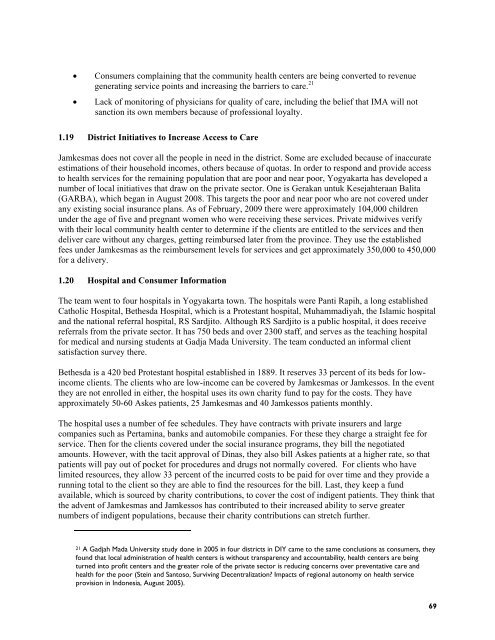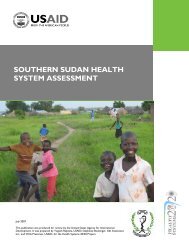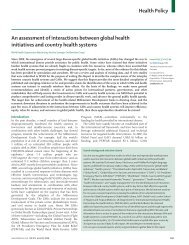PRIVATE SECTOR HEALTH CARE IN INDONESIA - Health Systems ...
PRIVATE SECTOR HEALTH CARE IN INDONESIA - Health Systems ...
PRIVATE SECTOR HEALTH CARE IN INDONESIA - Health Systems ...
- No tags were found...
Create successful ePaper yourself
Turn your PDF publications into a flip-book with our unique Google optimized e-Paper software.
• Consumers complaining that the community health centers are being converted to revenuegenerating service points and increasing the barriers to care. 21• Lack of monitoring of physicians for quality of care, including the belief that IMA will notsanction its own members because of professional loyalty.1.19 District Initiatives to Increase Access to CareJamkesmas does not cover all the people in need in the district. Some are excluded because of inaccurateestimations of their household incomes, others because of quotas. In order to respond and provide accessto health services for the remaining population that are poor and near poor, Yogyakarta has developed anumber of local initiatives that draw on the private sector. One is Gerakan untuk Kesejahteraan Balita(GARBA), which began in August 2008. This targets the poor and near poor who are not covered underany existing social insurance plans. As of February, 2009 there were approximately 104,000 childrenunder the age of five and pregnant women who were receiving these services. Private midwives verifywith their local community health center to determine if the clients are entitled to the services and thendeliver care without any charges, getting reimbursed later from the province. They use the establishedfees under Jamkesmas as the reimbursement levels for services and get approximately 350,000 to 450,000for a delivery.1.20 Hospital and Consumer InformationThe team went to four hospitals in Yogyakarta town. The hospitals were Panti Rapih, a long establishedCatholic Hospital, Bethesda Hospital, which is a Protestant hospital, Muhammadiyah, the Islamic hospitaland the national referral hospital, RS Sardjito. Although RS Sardjito is a public hospital, it does receivereferrals from the private sector. It has 750 beds and over 2300 staff, and serves as the teaching hospitalfor medical and nursing students at Gadja Mada University. The team conducted an informal clientsatisfaction survey there.Bethesda is a 420 bed Protestant hospital established in 1889. It reserves 33 percent of its beds for lowincomeclients. The clients who are low-income can be covered by Jamkesmas or Jamkessos. In the eventthey are not enrolled in either, the hospital uses its own charity fund to pay for the costs. They haveapproximately 50-60 Askes patients, 25 Jamkesmas and 40 Jamkessos patients monthly.The hospital uses a number of fee schedules. They have contracts with private insurers and largecompanies such as Pertamina, banks and automobile companies. For these they charge a straight fee forservice. Then for the clients covered under the social insurance programs, they bill the negotiatedamounts. However, with the tacit approval of Dinas, they also bill Askes patients at a higher rate, so thatpatients will pay out of pocket for procedures and drugs not normally covered. For clients who havelimited resources, they allow 33 percent of the incurred costs to be paid for over time and they provide arunning total to the client so they are able to find the resources for the bill. Last, they keep a fundavailable, which is sourced by charity contributions, to cover the cost of indigent patients. They think thatthe advent of Jamkesmas and Jamkessos has contributed to their increased ability to serve greaternumbers of indigent populations, because their charity contributions can stretch further.21 A Gadjah Mada University study done in 2005 in four districts in DIY came to the same conclusions as consumers, theyfound that local administration of health centers is without transparency and accountability, health centers are beingturned into profit centers and the greater role of the private sector is reducing concerns over preventative care andhealth for the poor (Stein and Santoso, Surviving Decentralization? Impacts of regional autonomy on health serviceprovision in Indonesia, August 2005).69
















